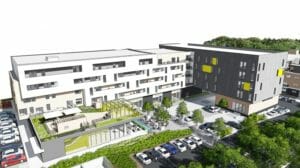Top Story
Member Spotlight with Jeremy Hudson: There is Economic Value in Building for Health
June 8, 2016
The Building Healthy Places Initiative member spotlight highlights the work and expertise of a ULI member working at the intersection of health and the built environment.
Jeremy Hudson is CEO of Specialized Real Estate Group in Fayetteville, Arkansas, a company focused on developing and managing walkable, healthy, and sustainable multifamily communities. He has developed over 1.3 million square feet of apartment buildings that are registered for LEED certification, including the award-winning Eco Modern Flats.
In October of 2014, Jeremy was named to the Urban Land Institute’s first-ever 40 Under 40 class, which recognizes the best and brightest young land use professionals from around the globe. Jeremy is a graduate of John Brown University with a degree in Construction Management and Business Administration.
How have you seen the focus on human health evolve within the design, land use, and real estate fields over the past several years?
If you look at the field 10 or 15 years ago, the focus was very much on sustainability from a ‘planet’ perspective. We knew that we needed to start implementing ideas that made more ecological sense, but it was a broader concept. Now, from our perspective, the focus has shifted to making a more tangible impact, specifically on human health. It started through a more pragmatic look at new construction, with regards to air quality and the materials we used, to now really focusing on creating a healthy community with a high quality of life, not just physically, but also emotionally. We now have a more clear understanding of what contributes to being happy and healthy where you live.
How are you currently working to integrate health into your development projects?

Rendering of Uptown, a pedestrian-friendly, trailside apartment community currently under construction.
It started for us with an Indoor Air Quality Pledge that we adopted 4 or 5 years ago, that we follow not just in our new construction, but also in any existing properties under management. From there, we’ve really begun to approach the design of each of our projects, from the interiors to the landscaping, with a very purposeful intention to create a community. To us, that means encouraging human interaction, access to nature, food, and activity. We have community gardens in most of our properties that facilitate all four of those values, and we will be starting a “farmer in residence” program at our latest development, Uptown. In one of our buildings in downtown Fayetteville, we dropped a small coffee shop in between several retail shops and have seen the area become a gathering place for those living and working in the area. In northwest Arkansas, we are fortunate to have an extensive bike and walking trail system, and we have taken advantage of that by building on that system as much as possible, making our developments connected, walkable, and surrounded by nature.
Where do you see the fields of real estate and land use needing to focus efforts in order to ensure that health is at the forefront when making project decisions?
We have to continue to emphasize education and awareness for developers, designers, and planners on how to make smart, healthy decisions, but also why. We see now that the market prefers a more sustainable, walkable, more connected lifestyle, so there is great economic value in building this way, but we need more research to show this is the case. Getting cities to understand this more holistic approach to development is key, and if we can get entire regions to see the importance and effect of making healthy places, we’ll continue to be on the right track.